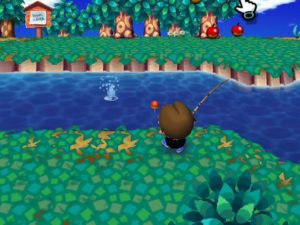Animal Crossing – The Hooks of a Social Simulation
May 30th, 2018
The Animal Crossing games have a unique talent of engaging player interest over a sustained period of time. However, the titles don’t rely on the traditional challenge-skill-reward loop of most video games. Rather, the genius of Animal Crossing is in how it uses systems of the everyday to draw the player into its social simulation.
Time Cycle
Animal Crossing‘s game world reveals itself over time as the internal clock (in conjunction with other measures and timers) triggers a host of behaviours and scenarios. These include, but are not limited to:
-
Weather patterns;
-
The presence of flowers, fruit, fish, insects, and fossils;
-
The coming and going of your neighbours;
-
Festivals;
-
The dialogue of individual characters;
-
The availability of products;
-
Access to the general store.
The player’s response (or lack of response) to each time window ripples forward through the game world. Chat with your neighbours regularly and they’ll be more inclined to remain in the village. Forget to check in on your town for a month and it’ll become infested with weeds. The time cycle encourages the player to play a little each day over an extended duration of time to maintain the smooth running of the village.
Game World
Animal Crossing is set within the confines of your reasonably small village. The size of the game world, in combination with its Truman Show-esque clockwork of daily activity, emphasises the small, evolving details (what *insert favourite animal friend* is going to say today, the new item on sale at Tom Nook’s store, the growing of a sapling into a tree, etc).
The Hooks
The time cycle and compact size of the township facilitate the social sim’s first hook—the characters. By virtue of the player moving around the confined space of the village and the characters going about their daily routines, the player is likely to stumble upon the animal characters and, in good odds, talk to them. Your neighbours are, after all, the most dynamic and interactive game element in town. Even if players choose to ignore the population of zoo creatures, their furry friends will occasionally run over to ask a question or dispel of some random thought bubble or throwaway piece of furniture. Tom Nook’s initial errands also set a precedence by sending the player out to interact with potential customers and chase debts. Needless to say, your animal friends are pretty hard to avoid.
It’s through the process of regularly seeing and interacting with your neighbours that you come to form an affection for them, not unlike real life. This affection is helped along in great part by the incredible localisation which makes each personality larger than life. The animals will call you a friend, give you nicknames, spout out their own personalised catch phrases, and share their obscure and funny musings on the world around them. They’re engineered to be loved.
The second hook can be explained much more simply: customisation. The Animal Crossing games present the player with a wealth of customisation options. The player can modify the avatar’s name, hair style, clothes, house, furniture, wallpaper, flooring, and the name of the village. Once the foundation is laid, new opportunities for creative ownership arise in the form of the animal characters asking the player for opinions, catch phrases, and secret best friend codes. The power of customisation is that it gives the player a sense of ownership over the game world because it asks that they invest some of their creative energy into shaping the fictional environment.
The phenomenon described above is similar in nature to the third hook: player agency. As mentioned previously, many of the player actions ripple forward through time and your town thereby becomes a collective representation of your individual experiences. The more you play and the more of yourself you invest into the game world, the more of that investment is reflected back at you through gameplay.
Conclusion
Animal Crossing‘s real-world time cycle encourages the player to play the game regularly over an extended period of time. The small size of each village makes it difficult to avoid the population of animal characters going about their daily routines. It’s the frequent interactions with these characters as well as the many opportunities to customise and affect the game world which allow the player to be drawn into Animal Crossing‘s social simulation.




 Game Design Companion: A Critical Analysis of Wario Land 4 - $7.99
Game Design Companion: A Critical Analysis of Wario Land 4 - $7.99 Level Design: Processes and Experiences
Level Design: Processes and Experiences Speed Boost: The Hidden Secrets Behind Arcade Racing Design - $5.99
Speed Boost: The Hidden Secrets Behind Arcade Racing Design - $5.99 Adventures in Games Analysis: Volume I - $5.99
Adventures in Games Analysis: Volume I - $5.99







